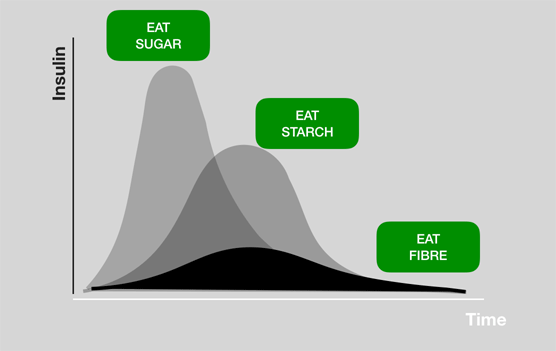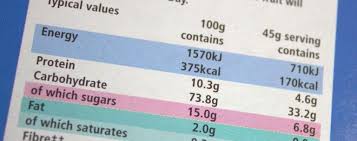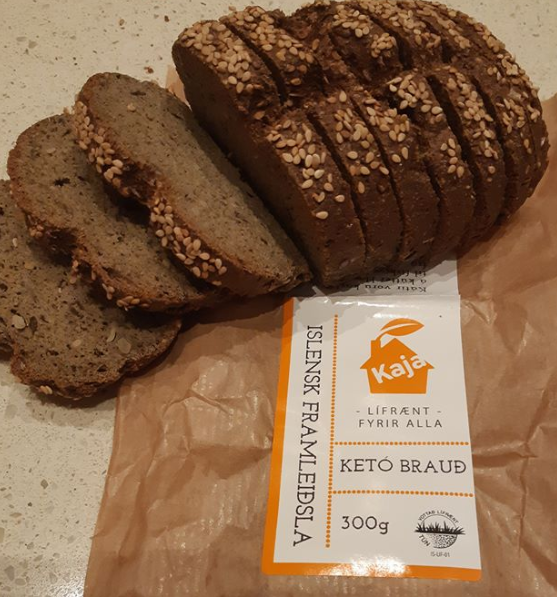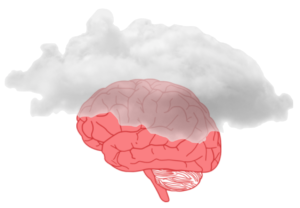It started with a smoothie….

My low sugar, low starch journey started a few years ago when Nutribullets were the ‘must have’ item. Like many, I bought one and started making so-called healthy smoothies. Lots of fruit, a bit of fruit juice, a few green leaves and hey presto, a nutrient-packed drink.
There was however one BIG draw-back. Within an hour of drinking one of these smoothies my energy levels crashed through the floor. And it was absolutely reproducible: Drink a smoothie and sixty minutes later I was struggling to keep my eyes open.
My knowledge of sugar metabolism made me think that all these ‘healthy’ fruits, mashed conveniently into a smoothie, were providing me with a sudden hit of sugar. Yes, all natural sugars (well, perhaps not so natural if you look at the ingredient list of most fruit juices) but nonetheless a sudden hit of sugar. This was then causing a spike in my blood sugar which in turn caused a spike in my insulin levels. The energy dip was the blood sugar crash that follows repeated sudden insulin spikes.

Making this discovery coincided with a number of documentaries on the BBC about the perils of high sugar diets, albeit that most of the (then) warnings were related to processed sugars in confectionary and breakfast cereals. The message hit home: Cut the sugar!
And so I did.

Research on the Internet indicated that diabetics are advised to avoid foods having more than 10 grams of sugar per 100 grams (where there is food labelling, of course). Being of a somewhat obsessive personality, I decided to set my working rule to just 5 grams per 100 grams. Out came the black bin bag and I disposed of everything in the fridge and store cupboards that exceeded this rule. There was no “…I’ll just finish that first…”. Every offending food was destroyed, fed to the birds or recycled.
The changes were dramatic. in the space of eight weeks, I lost 22lbs in weight, generally had more energy and no more energy crashes. Despite thinking that I might do this for just a couple of months to get my insulin mechanism back on track, I actually found that my palate changed and no longer could I stomach foods with even just a little bit of sugar in them. This was a one-way journey and I had left sugar behind.

The weight loss was achieved without counting a single calorie. What I noticed was that I was eating less but that was because I was naturally full – cravings and nibbling between meals had become a thing of the past.
This dietary change also coincided with a change in my exercise regime. I have always been a regular exerciser but at around this time I joined one of the first 24-hour gyms in my local area. Not only was I now able to access an exercise space at any time – I no longer had to clock-watch on rushed workouts between patients – but that large modern exercise space allowed me to explore the benefits of HIITs.
I had read Gretchen Reynolds excellent book “The First Twenty Minutes” and this new exercise facility had all the space and equipment for me to incorporate High Intensity Interval Training (HIIT) into my workout sessions. The appetite suppressing effects of HIITs undoubtedly added to the effectiveness of my new dietary regime.
My weight stayed about the same for the next couple of years, I no longer wanted sugar and this way of eating became the new ‘norm’ for me. I did not feel that I was on a ‘diet’ at all
Stage two of the dietary change then happened a few years later.

I am a regular visitor to Iceland and one thing that Icelanders do very well is bread. In many of their remote communities, the bakery is still the local hub where people meet and greet and catch-up on the latest news and gossip. The love and passion in their bread-making reflects how important the bakeries are to these communities. As Icelandic bread is so very good, I had got into a habit of eliminating bread in the few weeks before each trip to Iceland: If I cut-down my bread consumption prior to each trip then I could enjoy plenty of Icelandic bread without any guilt once I was there.
And then I noticed the pattern of how much better I felt in those weeks running up to each trip. Each time I cut down on bread I felt lighter, less sluggish and had more energy. Of course, a little thought and it is quite obvious why that should be – although I had cut dietary sugar, I was still eating starches (not just in bread, but in rice, potatoes, pasta etc) and these starches were being converted into sugars in my gut and thereby still triggering an insulin response.
So I took the big step to cut most starches out of my diet as well as the sugars. No more bread, pasta, rice or potatoes. Instead lots of steamed or roasted leafy fibrous vegetables, dairy, protein from meat and fish sources and lots of natural intrinsic fats. I was now a fully subscribed member of the low carbohydrate way of eating.

Yes, there was more weight loss but by far the biggest change was the clearing of the ‘brain fog’. I had read about this in the personal accounts of others on the low carbohydrate regime but had not really understood what they meant. Until the day my brain fog lifted.

The mental sharpness and clarity that comes with cutting the carbs is for me the most treasured benefit of this way of eating. It enables me to do so many things that before would have seemed too much effort.
One of those things I have managed now the fog has lifted is ‘devouring’ as many books on food, diet, nutrition and low carbohydrate eating as I can get my hands on.
My library of books is ever increasing and through the medium of this website I plan to share with you some of the distilled information from all that reading!
